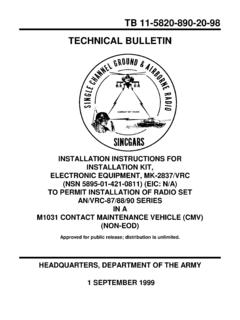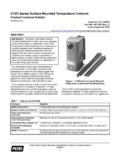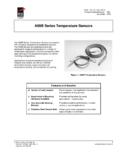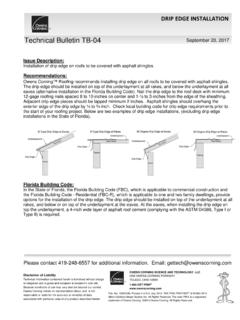Transcription of TECHNICAL BULLETIN Understanding Aspect Ratios
1 TECHNICAL BULLETINU nderstanding Aspect Ratios CinemaSource TECHNICAL Bulletins. Copyright 2001 by CinemaSource, rights reserved. Printed in the United States of America. No part of this BULLETIN may be used or reproduced in any manner whatsoever without written permission,except in brief quotations embodied in critical reviews. CinemaSourceis a registered federal information contact: The CinemaSource Press, 18 Denbow Rd. Durham, NH 038243 Understanding Aspect RatiosUnderstanding Aspect Ratios The first thing we want to do is demystify this Aspect ratio is simply a numerical way ofdescribing a rectangular shape.
2 The Aspect ratio ofyour standard television, for example, is 4:3. This meansthat the picture is 4 units wide and 3 units , professional cinematographers tend to prefera single number to describe screen shapes and reducethe familiar 4:3 television ratio down to :1, or just is most likely because they deal with a vastly largernumber of screen shapes than television people do andout of necessity, long ago, jettisoned bulky fractionaldescriptions. The History Of Cinema Aspect RatiosThe original Aspect ratio utilized by the motion pictureindustry was 4:3 and according to historical accounts, wasdecided in the late 19th century by Thomas Edison whilehe was working with one of his chief assistants, Dickson.
3 As the story goes, Dickson was working witha new 70MM celluloid-based film stock supplied byphotographic entrepreneur George Eastman. Because the70MM format was considered unnecessarily wasteful byEdison, he asked Dickson to cut it down into smallerstrips. When Dickson asked Edison what shape he wantedimaged on these strips, Edison replied, "about like this"and held his fingers apart in the shape of a rectangle withapproximately a 4:3 Aspect ratio. Over the years there hasbeen quite a bit of conjecture about what Edison had inmind when he dictated this shape. Theories vary fromfrom Euclid's famous Greek "Golden Section", a shape ofapproximately to 1, to a shape that simply savedmoney by cutting the existing 70MM Eastman film stock inhalf.
4 Whatever the true story may be, Edison's 4:3 aspectratio was officially adopted in 1917 by the Society OfMotion Picture Engineers as their first engineeringstandard, and the film industry used it almost exclusivelyfor the next 35 of the early precedent set by the motion pictureindustry with the 4:3 Aspect ratio, the television industryadopted the same when television broadcasting began inthe 1930s, and today the 4:3 Aspect ratio is still thestandard for virtually all television monitor and receiverdesigns. The same situation applies to video programmingand software. Only until recently has there been anysoftware available except in 4:3 format (letterboxed videosare the same thing electronically).
5 There simply wasn't anyreason to shoot or transfer in any other Aspect ratiobecause of the standard 4:3 shape of the televisiondisplays. For the home theater owner, this situation meansthat compatibility issues are essentially nonexistent withUnderstanding Aspect Ratios4standard 4:3 television receivers and standard 4:3programming. They are all "plug and play", so to speak, atleast when it comes to the shape of WideBack to our history lesson. After many years ofexperimentation, television broadcasting formally beganon April 30, 1939 when NBC broadcasted FranklinRoosevelt's opening of the 1939 World's Fair.
6 As youmight imagine, the availability of a device that deliveredsound and pictures in the home immediately concernedthe Hollywood studios. After all, this medium had thepotential to erode their lifeblood; their vital payingcustomer base. When color was introduced in late 1953,the studios stopped wringing their hands and sprang intoaction. The result was the rapid development of amultitude of new widescreen projection Ratios and severalmultichannel sound formats. Today, just a few of thesewidescreen formats survive,but a permanent parting of theways had occurred: film wasnow a wide Aspect ratiomedium, and televisionremained at the academystandard 4:3 Aspect we mentioned, the fact thatfilm formats went wide in the1950s never really impactedthe production end oftelevision.
7 Everything stayedat 4:3 for them because of theuniformity of 4:3 televisiondesign. However, the transferof motion pictures was another story. The question is: How doyou make a wide shape fit into a narrow one? One wayyou've undoubtedly heard about "panning and scanning".This technique of transferring film to video requires that atelecine (video transfer) operator crop a smaller 4:3section out of a widescreen movie while panning aroundfollowing the movie's action. This technique, whenproperly done, actually works pretty well, but not everyonelikes the artistic compromise of "throwing away part of thedirector's vision".
8 Not the least of which is the filmdirectors themselves, and one of the first to really object tothis process was Woody Allen. In 1979, when his filmManhattan was being transferred for television release, hesteadfastly refused to have it panned and scanned. Heinsisted that the feature be shown with the widescreenaspect ratio intact, and this lead to the technique of"letterboxing". Letterboxing, a method where the middle ofa 4:3 image is filled with a smaller, but wider, Aspect ratioimage, may have had the blessing of Hollywood directorsbut was originally shunned by the viewing public.
9 Theobjection was the black bars on the top and the bottom ofthe picture, people just didn't like them. Today, letterboxinghas gained much broader acceptance and you can find itavailable from sources such as prerecorded tapes(occasionally), broadcast television (occasionally), oncable and DSS (AMC and other movie channels broadcastin letterbox), on laserdisc (fairly common), and DVDreleases (very common).So, what about displaying letterbox material with aprojection display? On a standard 4:3 display, the situationis pretty simple, letterboxed software can be seenbasically one way: as a stripe across the center of thedisplay with black bars top and bottom.
10 On a widescreendisplay, you can do something different. The letterboxsection of the frame can be "zoomed into" so that theimage fills the wider screen essentially eliminating theblack bars. What is interesting about this technique is thatit is conceptually similar to what is done in professionalcinemas with standard widescreen releases with "matting".Our diagrams on following at the end of this chapterillustrate this. By zooming theletterbox section in to fill thescreen, the audience simplysees a widescreen image. Themain difference between videodisplay and film display,however, is the way thezooming is done.







